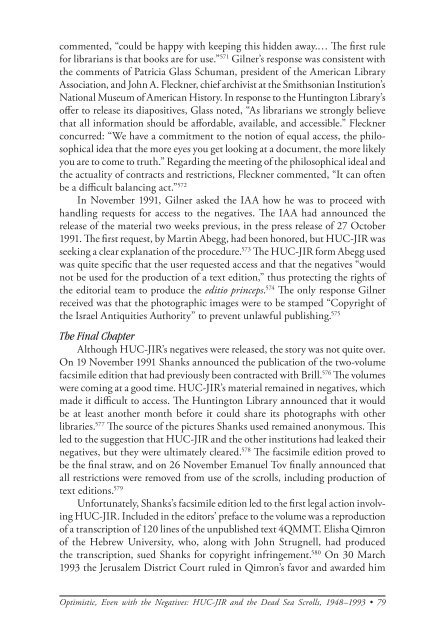The American Jewish Archives Journal, Volume LXI 2009, Number 1
The American Jewish Archives Journal, Volume LXI 2009, Number 1
The American Jewish Archives Journal, Volume LXI 2009, Number 1
You also want an ePaper? Increase the reach of your titles
YUMPU automatically turns print PDFs into web optimized ePapers that Google loves.
commented, “could be happy with keeping this hidden away.… <strong>The</strong> first rule<br />
for librarians is that books are for use.” 571 Gilner’s response was consistent with<br />
the comments of Patricia Glass Schuman, president of the <strong>American</strong> Library<br />
Association, and John A. Fleckner, chief archivist at the Smithsonian Institution’s<br />
National Museum of <strong>American</strong> History. In response to the Huntington Library’s<br />
offer to release its diapositives, Glass noted, “As librarians we strongly believe<br />
that all information should be affordable, available, and accessible.” Fleckner<br />
concurred: “We have a commitment to the notion of equal access, the philosophical<br />
idea that the more eyes you get looking at a document, the more likely<br />
you are to come to truth.” Regarding the meeting of the philosophical ideal and<br />
the actuality of contracts and restrictions, Fleckner commented, “It can often<br />
be a difficult balancing act.” 572<br />
In November 1991, Gilner asked the IAA how he was to proceed with<br />
handling requests for access to the negatives. <strong>The</strong> IAA had announced the<br />
release of the material two weeks previous, in the press release of 27 October<br />
1991. <strong>The</strong> first request, by Martin Abegg, had been honored, but HUC-JIR was<br />
seeking a clear explanation of the procedure. 573 <strong>The</strong> HUC-JIR form Abegg used<br />
was quite specific that the user requested access and that the negatives “would<br />
not be used for the production of a text edition,” thus protecting the rights of<br />
the editorial team to produce the editio princeps. 574 <strong>The</strong> only response Gilner<br />
received was that the photographic images were to be stamped “Copyright of<br />
the Israel Antiquities Authority” to prevent unlawful publishing. 575<br />
<strong>The</strong> Final Chapter<br />
Although HUC-JIR’s negatives were released, the story was not quite over.<br />
On 19 November 1991 Shanks announced the publication of the two-volume<br />
facsimile edition that had previously been contracted with Brill. 576 <strong>The</strong> volumes<br />
were coming at a good time. HUC-JIR’s material remained in negatives, which<br />
made it difficult to access. <strong>The</strong> Huntington Library announced that it would<br />
be at least another month before it could share its photographs with other<br />
libraries. 577 <strong>The</strong> source of the pictures Shanks used remained anonymous. This<br />
led to the suggestion that HUC-JIR and the other institutions had leaked their<br />
negatives, but they were ultimately cleared. 578 <strong>The</strong> facsimile edition proved to<br />
be the final straw, and on 26 November Emanuel Tov finally announced that<br />
all restrictions were removed from use of the scrolls, including production of<br />
text editions. 579<br />
Unfortunately, Shanks’s facsimile edition led to the first legal action involving<br />
HUC-JIR. Included in the editors’ preface to the volume was a reproduction<br />
of a transcription of 120 lines of the unpublished text 4QMMT. Elisha Qimron<br />
of the Hebrew University, who, along with John Strugnell, had produced<br />
the transcription, sued Shanks for copyright infringement. 580 On 30 March<br />
1993 the Jerusalem District Court ruled in Qimron’s favor and awarded him<br />
Optimistic, Even with the Negatives: HUC-JIR and the Dead Sea Scrolls, 1948–1993 • 79

















